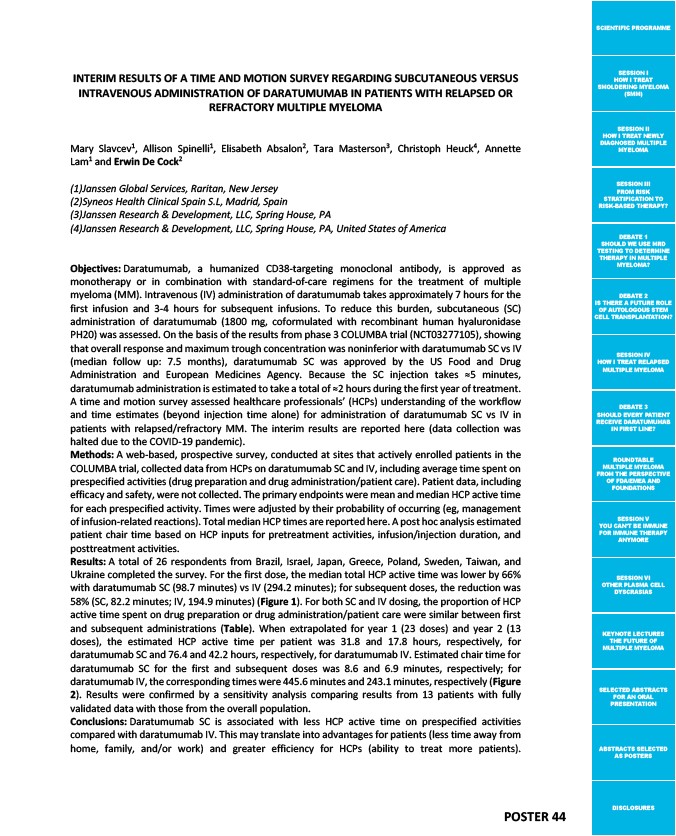
SCIENTIFIC PROGRAMME
SESSION I
HOW I TREAT
SMOLDERING MYELOMA
(SMM)
SESSION II
HOW I TREAT NEWLY
DIAGNOSED MULTIPLE
MYELOMA
SESSION III
FROM RISK
STRATIFICATION TO
RISK-BASED THERAPY?
DEBATE 1
SHOULD WE USE MRD
TESTING TO DETERMINE
THERAPY IN MULTIPLE
MYELOMA?
DEBATE 2
IS THERE A FUTURE ROLE
OF AUTOLOGOUS STEM
CELL TRANSPLANTATION?
SESSION IV
HOW I TREAT RELAPSED
MULTIPLE MYELOMA
DEBATE 3
SHOULD EVERY PATIENT
RECEIVE DARATUMUMAB
IN FIRST LINE?
ROUNDTABLE
MULTIPLE MYELOMA
FROM THE PERSPECTIVE
OF FDA/EMEA AND
FOUNDATIONS
SESSION V
YOU CAN’T BE IMMUNE
FOR IMMUNE THERAPY
ANYMORE
SESSION VI
OTHER PLASMA CELL
DYSCRASIAS
KEYNOTE LECTURES
THE FUTURE OF
MULTIPLE MYELOMA
SELECTED ABSTRACTS
FOR AN ORAL
PRESENTATION
ABSTRACTS SELECTED
AS POSTERS
INTERIM RESULTS OF A TIME AND MOTION SURVEY REGARDING SUBCUTANEOUS VERSUS
INTRAVENOUS ADMINISTRATION OF DARATUMUMAB IN PATIENTS WITH RELAPSED OR
DISCLOSURES POSTER 44
REFRACTORY MULTIPLE MYELOMA
Mary Slavcev1, Allison Spinelli1, Elisabeth Absalon2, Tara Masterson3, Christoph Heuck4, Annette
Lam1 and Erwin De Cock2
(1)Janssen Global Services, Raritan, New Jersey
(2)Syneos Health Clinical Spain S.L, Madrid, Spain
(3)Janssen Research & Development, LLC, Spring House, PA
(4)Janssen Research & Development, LLC, Spring House, PA, United States of America
Objectives: Daratumumab, a humanized CD38-targeting monoclonal antibody, is approved as
monotherapy or in combination with standard-of-care regimens for the treatment of multiple
myeloma (MM). Intravenous (IV) administration of daratumumab takes approximately 7 hours for the
first infusion and 3-4 hours for subsequent infusions. To reduce this burden, subcutaneous (SC)
administration of daratumumab (1800 mg, coformulated with recombinant human hyaluronidase
PH20) was assessed. On the basis of the results from phase 3 COLUMBA trial (NCT03277105), showing
that overall response and maximum trough concentration was noninferior with daratumumab SC vs IV
(median follow up: 7.5 months), daratumumab SC was approved by the US Food and Drug
Administration and European Medicines Agency. Because the SC injection takes ≈5 minutes,
daratumumab administration is estimated to take a total of ≈2 hours during the first year of treatment.
A time and motion survey assessed healthcare professionals’ (HCPs) understanding of the workflow
and time estimates (beyond injection time alone) for administration of daratumumab SC vs IV in
patients with relapsed/refractory MM. The interim results are reported here (data collection was
halted due to the COVID-19 pandemic).
Methods: A web-based, prospective survey, conducted at sites that actively enrolled patients in the
COLUMBA trial, collected data from HCPs on daratumumab SC and IV, including average time spent on
prespecified activities (drug preparation and drug administration/patient care). Patient data, including
efficacy and safety, were not collected. The primary endpoints were mean and median HCP active time
for each prespecified activity. Times were adjusted by their probability of occurring (eg, management
of infusion-related reactions). Total median HCP times are reported here. A post hoc analysis estimated
patient chair time based on HCP inputs for pretreatment activities, infusion/injection duration, and
posttreatment activities.
Results: A total of 26 respondents from Brazil, Israel, Japan, Greece, Poland, Sweden, Taiwan, and
Ukraine completed the survey. For the first dose, the median total HCP active time was lower by 66%
with daratumumab SC (98.7 minutes) vs IV (294.2 minutes); for subsequent doses, the reduction was
58% (SC, 82.2 minutes; IV, 194.9 minutes) (Figure 1). For both SC and IV dosing, the proportion of HCP
active time spent on drug preparation or drug administration/patient care were similar between first
and subsequent administrations (Table). When extrapolated for year 1 (23 doses) and year 2 (13
doses), the estimated HCP active time per patient was 31.8 and 17.8 hours, respectively, for
daratumumab SC and 76.4 and 42.2 hours, respectively, for daratumumab IV. Estimated chair time for
daratumumab SC for the first and subsequent doses was 8.6 and 6.9 minutes, respectively; for
daratumumab IV, the corresponding times were 445.6 minutes and 243.1 minutes, respectively (Figure
2). Results were confirmed by a sensitivity analysis comparing results from 13 patients with fully
validated data with those from the overall population.
Conclusions: Daratumumab SC is associated with less HCP active time on prespecified activities
compared with daratumumab IV. This may translate into advantages for patients (less time away from
home, family, and/or work) and greater efficiency for HCPs (ability to treat more patients).